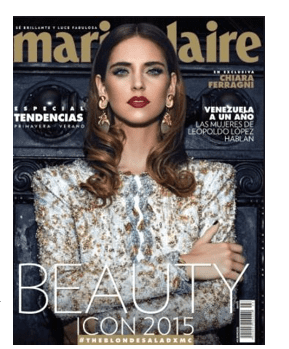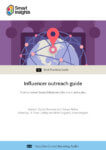An example of the growing importance of online influencer outreach in marketing today
Whether you diligently follow the fashion world or just check out magazine covers when you’re standing in line at Target, you’ll probably notice something subtly out of character about the March 2015 cover of Marie Claire.

The Italian cover girl isn’t a model, an actress, or even a celebrity. She’s a fashion blogger with a firm grip on the interests of fashion fans around the world. And she’s one of many reasons you should be looking into the role that digital influencers can play in your marketing strategy.
Digital Influence is changing
Leveraging fashion influencers is a great example of a shift in the world of marketing. True influence is no longer about paid celebrity product endorsements in film, television, and print. It’s about genuine, personal recommendations from believable and authentic digital personalities.
Nowhere is this transition more evident than in the world of fashion. Top brands like Louis Vuitton, Dior, and Cartier are connecting with social media stars who have a deep, personal connection with their audience around the globe. And digital marketers in all industries should carefully watch to see how this new strategy could help them connect with online audiences.
Before you start to wonder whether the traditional sponsored partnership routine is still the way to go, consider the maths. The once-per-month reach of popular fashion magazines like Cosmopolitan and Vogue — 3 million and 1.2 million paid subscriptions, respectively, pales in comparison to the full-time access to fashion that bloggers have gained through their social media style mentors.
Teri Cosenzi’s Beautiful Makeup Search blog reaches 3.1 million people every day through YouTube, Twitter, and Facebook. Chiara Ferragni of The Blonde Salad reaches more than 4 million people through Facebook and Instagram. And Zoe Sugg, a style and fashion vlogger on YouTube, has 7.6 million followers.
A post from these influencers reaches one to two times the range of top fashion magazines or, in Sugg’s case, the top four fashion magazine subscriptions combined. These posts reach fans in the most intimate setting possible: their personal networks, where they spend hours perusing, liking, retweeting, and sharing.
How did they achieve such success individually?
Cosenzi’s message board post about a beauty product review made her realize that other women were also looking for an outlet to review beauty products, saving them money and time spent testing the products themselves. Beautiful Makeup Search was one of the only sites providing this service when it was established, drawing the attention of several beauty brands in the process.
Ferragni, on the other hand, stumbled upon her success. When she launched The Blonde Salad in 2009, luxury brands were just beginning to dip their toes into the world of e-commerce and sought influencers like Ferragni. She pioneered blogger product placement by featuring a journey she’d taken in a particular outfit, featuring links to buy the items in the text.
Sugg’s on-camera personality has made her YouTube channel a juggernaut. Her wholesome vibe and commitment to two-way communication, answering questions, responding to comments, and acting on suggested video topics enables her viewers to feel connected to her.
Beyond reach, influencer marketing provides several clear benefits to brands looking to make an impact online:
- Digital influencers help brands reach very targeted audiences. Digital influencers carefully curate fan bases with specific characteristics. Brands that connect with these influencers also get to connect with these specific audiences. For example, Sears developed a clothing campaign for Hispanic women by partnering with digital influencers to zero in on a multicultural audience and deliver its message through influencers whom prospective customers could trust.
- Customers don’t connect with celebrities the way they do with 'real people.' The digital generation doesn’t identify with mannequins and models as deeply as it does with real people. In fashion, that translates into powerful photos of designer shoes on an everyday fashion blogger’s Instagram, not an unreachable model on a recent runway shoot.
- Paid sponsorships don’t feel authentic anymore. Celebrities and other famous people used to deliver the most popular and effective endorsements. Consumers now look to the opinions and experiences of everyday people to guide their purchase decisions. In the process of devoting their attention to blogs and social media, these digital influencers carry tremendous weight.
How to build a Powerhouse Network
Ready to apply this successful strategy to your own brand? Here are four things you need to do to work with a powerful digital influencer:
- 1. Research your audience to find an influencer who reflects your unique brand. Don’t reason that a blogger will be a good fit for your brand simply because she’s popular. Research the needs and interests of your target audience to determine which influencer will be the best fit for your campaign or promotion (and whose personality aligns with your brand values). Start by finding the influencers who are already talking about your brand or product. If they’re current advocates for your brand, they’ll be more likely to accept your pitch.
Finding the right influencer may be as easy as performing a Google search. This simple search method for discovering influencers is the first step to outlining your options.
However, platforms and networks are the best way to progress in your search. Platforms like TapInfluence, Little Bird, and inPowered find influencers based on topical authority, geography, and other circumstances. Databases such as GroupHigh or Cision enable you to connect to these influencers as well.
- 2. Don’t assume that size is everything. Popular influencers likely get pitched 100 times a week. They also may be represented by a talent agency or manager and cost upwards of $50,000 per sponsored post. However, don’t expect that the relationship will deliver what you’re looking for just because the influencer is expensive.
There are thousands of mid-tier bloggers and influencers on Pinterest, Instagram, Vine, and YouTube who might have a smaller reach but could become amazing brand champions who fit your tight budget.
Mid-tier influencers, defined as those who have between 1,000 and 10,000 followers on social media, produce organic conversations that drive ideas. While their content isn’t likely to touch hundreds of thousands of people like an A-list influencer’s would, mid-tier influencers are more open to sharing your content more often, particularly if they love your brand. The more they share their enthusiasm, the more people will hear about your products.
- 3. Consider the extended reach of social influencers. Digital influencers network among other digital influencers. Take into account the extended reach of your sponsored post when other prominent bloggers share and link to the original promotion. The frequency with which influencers share each other’s content magnifies the reach of even the low- to mid-tier bloggers you connect with.
- 4. Bend the rules to tap into their creative genius. Social influencers know their audiences intimately. Don’t try to force them into pushing out your pre-written branded content. They either won’t do it or they’ll charge more. Digital influencers are content creators whose efforts are better, faster, and cheaper than your own. Tap into this creativity by letting your influencers take an idea and apply their own instincts.
The fashion industry’s rapid adoption of influencer marketing illustrates a global shift that is happening in all consumer verticals, personable, authentic marketing trumps expensive, heavy-handed endorsements. Marketers are challenged with trying to scale three major areas: reach, engagement, and consumer influence. Influencer marketing is a proven way to get all three.

Thanks to
Holly Hamann for sharing her advice and opinions in this post. Holly Hamann is the co-founder and CMO of
TapInfluence, the industry’s only cloud-based software that automates the creation, management, and measurement of influencer marketing programs. She has helped launch six web-based startups in the social, music, video, and entertainment spaces. She’s a public speaker, a board member of the Deming Center for Entrepreneurship, and an American Marketing Association “Marketer of the Year” recipient. Holly is an entrepreneur, a writer, and an active triathlete. You can follow her on
Twitter or connect on
LinkedIn.








